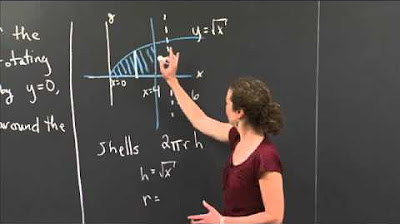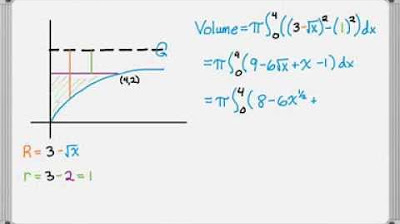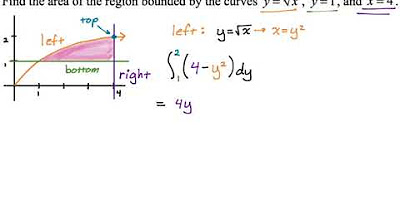Volume of a Paraboloid via Disks | MIT 18.01SC Single Variable Calculus, Fall 2010
TLDRIn this recitation video, the professor guides students through a solid of revolution problem using the disk method. The task is to find the volume of a solid formed by rotating the region bounded by x=0, y=5, and y=x^2+1 around the y-axis. The key step is determining the radius in terms of y, which is the square root of (y-1). The integration is performed from y=1 to y=5, with the integral of (y-1) representing the volume calculation. The professor emphasizes the importance of understanding the radius's dependency on y and the integration bounds to solve the problem.
Takeaways
- 📚 The class is focusing on solid of revolution problems, specifically calculating the volume of a solid generated by rotation.
- 🎯 The region of interest is bounded by x=0, y=5, and y=x^2+1, and the rotation is around the y-axis.
- 📝 The disk method is the chosen technique for solving this problem, which involves integrating the area of disks stacked along the axis of rotation.
- 🖌️ A rough sketch of the region is essential for visualizing the problem and understanding the limits of integration.
- 🔍 The parabola y=x^2+1 is identified and sketched, representing one of the boundaries of the region.
- 🔄 The rotation of the region around the y-axis is visualized to understand the shape of the solid that will be formed.
- 📐 The radius of the disks is determined in terms of y, using the equation y-1=x^2, which simplifies to the radius being √(y-1).
- 📉 The limits of integration for y are identified as 1 to 5, based on the boundaries of the region.
- ⌛ The integral to be solved is π times the radius squared, integrated over the range of y from 1 to 5.
- 📘 The integral simplifies to π times the integral of (y-1) with respect to y, which can be evaluated using polynomial integration rules.
- 🏁 The main takeaway is the importance of determining the radius in terms of y and the bounds for y to successfully integrate and find the volume.
Q & A
What is the main topic of the video?
-The main topic of the video is to find the volume of a solid of revolution generated by rotating a specific region bounded by three curves about the y-axis, using the disk method.
What are the three curves mentioned in the video that define the region for the solid of revolution?
-The three curves mentioned are x equals 0 (the y-axis), y equals 5, and y equals x squared plus 1 (a parabola shifted up by 1).
Why is it important to sketch the region before solving the problem?
-Sketching the region helps to visualize the area that will be rotated to form the solid, ensuring that the integration does not count any area twice and that the correct bounds are identified for the integration.
What is the disk method used for in this context?
-The disk method is used to calculate the volume of the solid by integrating the area of infinitesimally thin disks that would be formed when the region is rotated around the y-axis.
How is the radius of the disk determined in this problem?
-The radius of the disk is determined by the expression for x in terms of y, which is the square root of (y - 1), derived from the equation y = x squared plus 1.
What is the significance of finding the radius in terms of y?
-Finding the radius in terms of y is crucial because the integration is performed with respect to y, and the radius expression allows us to express the volume element in terms of y.
What are the lower and upper bounds for the integration in terms of y?
-The lower bound for the integration is y equals 1, and the upper bound is y equals 5, corresponding to the limits of the region where the curves intersect.
What is the integral that needs to be evaluated to find the volume of the solid?
-The integral to be evaluated is from 1 to 5 of pi times the square of the radius (y - 1) with respect to y.
Why is it important to avoid counting any area twice when rotating the region?
-Avoiding double counting ensures the accuracy of the volume calculation, as each point in the region should contribute to the volume of the solid only once.
What is the final step in solving the problem after setting up the integral?
-The final step is to evaluate the integral using the rules for polynomial integration to find the numerical value of the volume of the solid.
What does the professor emphasize as the main point of the problem?
-The professor emphasizes that the main point of the problem is to determine the radius in terms of y and to identify the correct bounds for y, which are essential for setting up and evaluating the integral.
Outlines
📚 Introduction to Solid of Revolution Problem
The professor begins the recitation by introducing a solid of revolution problem, specifically focusing on finding the volume of a solid generated by rotating a region bounded by the curves x=0, y=5, and y=x^2+1 around the y-axis. The disk method is emphasized as the preferred approach to solving this problem. The professor encourages students to first sketch the region and then proceed to apply the disk method, which involves determining the radius as a function of y, in this case, the square root of (y-1). The lower and upper bounds for the integration with respect to y are identified as y=1 and y=5, respectively.
🔍 Detailed Explanation of Disk Method Application
In the second paragraph, the professor elaborates on the disk method, highlighting the importance of expressing the radius in terms of y to facilitate the integration process. The professor explains the process of setting up the integral with pi times the radius squared and emphasizes the need to identify the correct bounds for y. The integral to be evaluated is from y=1 to y=5, with the radius expressed as y-1. The professor stops short of evaluating the integral, trusting that the students can complete the calculation. The main takeaway is the methodological approach to solving the problem, focusing on determining the radius in terms of y and the integration bounds.
Mindmap
Keywords
💡recitation
💡solid of revolution
💡disk method
💡volume
💡region
💡y-axis
💡parabola
💡integration
💡radius
💡bounds
💡polynomial
Highlights
Introduction to the recitation session and the problem of finding the volume of a solid of revolution using the disk method.
The problem involves rotating the region bounded by x=0, y=5, and y=x^2+1 around the y-axis.
Emphasis on using the disk method for calculating the volume of the solid.
Encouragement for students to attempt the problem before the professor provides a solution.
Explanation of the importance of sketching the region bounded by the curves for a better understanding.
Description of the region and the curves involved: x=0, y=5, and y=x^2+1.
Clarification that including the entire region or just the piece of interest results in the same solid when rotated.
The disk method requires determining the radius in terms of y, which is derived from the equation y=x^2+1.
Derivation of the radius expression as the square root of (y-1).
Identification of the bounds for integration in terms of y, which are y=1 and y=5.
Setting up the integral for the volume calculation using the disk method with the radius squared.
Integration of π times the radius squared over the range of y from 1 to 5.
The integral simplifies to π times the integral of (y-1) with respect to y.
The professor stops short of evaluating the integral, leaving it to the students to complete.
Emphasis on the importance of determining the radius in terms of y for the disk method.
Highlighting the simplicity of the integral evaluation once the radius and bounds are established.
Concluding remarks on the main takeaways from the problem-solving process.
Transcripts
Browse More Related Video

2022 AP Calculus BC Exam FRQ #5

Volume of Revolution via Shells | MIT 18.01SC Single Variable Calculus, Fall 2010

Volume of Revolution Examples - Horizontal Axis

Disc method around y-axis | Applications of definite integrals | AP Calculus AB | Khan Academy

Disc method rotating around vertical line | AP Calculus AB | Khan Academy

Area Between Curves: Integrating with Respect to y (Example 3)
5.0 / 5 (0 votes)
Thanks for rating: